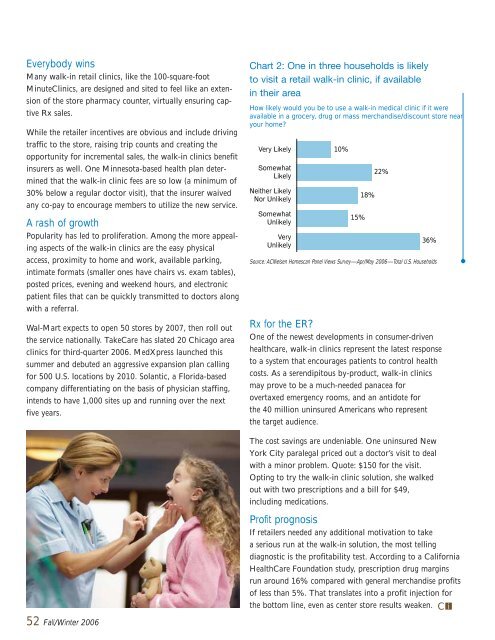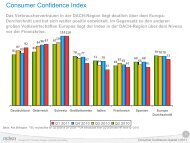Create successful ePaper yourself
Turn your PDF publications into a flip-book with our unique Google optimized e-Paper software.
Everybody wins<br />
Many walk-in retail clinics, like the 100-square-foot<br />
MinuteClinics, are designed and sited to feel like an extension<br />
of the store pharmacy counter, virtually ensuring captive<br />
Rx sales.<br />
While the retailer incentives are obvious and include driving<br />
traffic to the store, raising trip counts and creating the<br />
opportunity for incremental sales, the walk-in clinics benefit<br />
insurers as well. One Minnesota-based health plan determined<br />
that the walk-in clinic fees are so low (a minimum of<br />
30% below a regular doctor visit), that the insurer waived<br />
any co-pay to encourage members to utilize the new service.<br />
A rash of growth<br />
Popularity has led to proliferation. Among the more appealing<br />
aspects of the walk-in clinics are the easy physical<br />
access, proximity to home and work, available parking,<br />
intimate formats (smaller ones have chairs vs. exam tables),<br />
posted prices, evening and weekend hours, and electronic<br />
patient files that can be quickly transmitted to doctors along<br />
with a referral.<br />
Wal-Mart expects to open 50 stores by 2007, then roll out<br />
the service nationally. TakeCare has slated 20 Chicago area<br />
clinics for third-quarter 2006. MedXpress launched this<br />
summer and debuted an aggressive expansion plan calling<br />
for 500 U.S. locations by 2010. Solantic, a Florida-based<br />
company differentiating on the basis of physician staffing,<br />
intends to have 1,000 sites up and running over the next<br />
five years.<br />
Chart 2: One in three households is likely<br />
to visit a retail walk-in clinic, if available<br />
in their area<br />
How likely would you be to use a walk-in medical clinic if it were<br />
available in a grocery, drug or mass merchandise/discount store near<br />
your home?<br />
Very Likely 10%<br />
Somewhat<br />
Likely<br />
Neither Likely<br />
Nor Unlikely<br />
Somewhat<br />
Unlikely<br />
Very<br />
Unlikely<br />
15%<br />
18%<br />
22%<br />
36%<br />
Source: ACNielsen Homescan Panel Views Survey—Apr/May 2006—Total U.S. Households<br />
Rx for the ER?<br />
One of the newest developments in consumer-driven<br />
healthcare, walk-in clinics represent the latest response<br />
to a system that encourages patients to control health<br />
costs. As a serendipitous by-product, walk-in clinics<br />
may prove to be a much-needed panacea for<br />
overtaxed emergency rooms, and an antidote for<br />
the 40 million uninsured Americans who represent<br />
the target audience.<br />
The cost savings are undeniable. One uninsured New<br />
York City paralegal priced out a doctor’s visit to deal<br />
with a minor problem. Quote: $150 for the visit.<br />
Opting to try the walk-in clinic solution, she walked<br />
out with two prescriptions and a bill for $49,<br />
including medications.<br />
Profit prognosis<br />
If retailers needed any additional motivation to take<br />
a serious run at the walk-in solution, the most telling<br />
diagnostic is the profitability test. According to a California<br />
HealthCare Foundation study, prescription drug margins<br />
run around 16% compared with general merchandise profits<br />
of less than 5%. That translates into a profit injection for<br />
the bottom line, even as center store results weaken. C i<br />
52 Fall/Winter 2006











